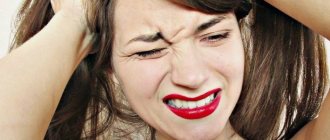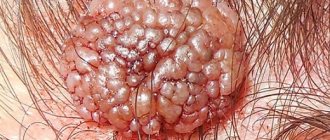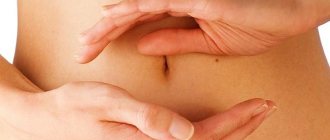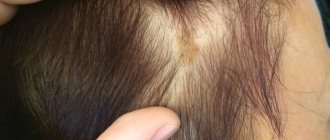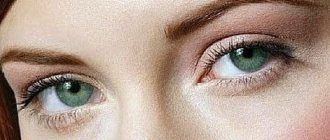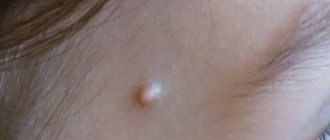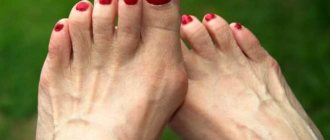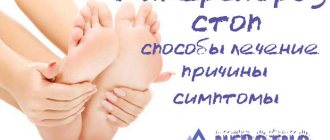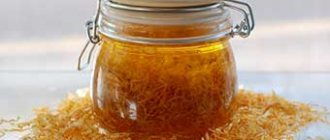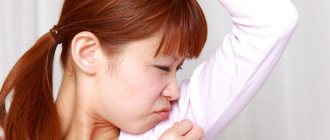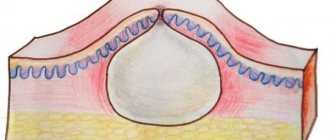Causes
When people think of acne, most people imagine a face covered in these unpleasant formations. However, pustules also appear on other parts of the body - the scalp, the back of the head, the back and front of the neck, the top of the head, etc. can be affected. If acne is a problem mainly for teenagers, then adult men and women also get pimples on the head.
The reasons for the formation of acne on the head are varied - from banal non-compliance with personal hygiene rules to serious pathologies of internal organs.
Important! Only an accurate diagnosis of the process that caused the rash will help quickly solve the problem.
Domestic
Among internal problems, diseases of internal organs and systems come first, provoking the process of blockage of the sebaceous glands.
The most incredible way to get my hair back!
This is just a DISASTER ! And after all, my hair did not start falling out in one day, but systematically - day after day I watched how the hair left my head: while combing, washing, even while sleeping. (read more…)
- diseases of the digestive system;
- hormonal imbalances caused by diseases of the endocrine and reproductive systems;
- nervous disorders, stress, depression;
- mechanical damage to the skin: wounds and cuts to the skin open the way for bacterial infection - the main provocateur of purulent rashes.
External
Unfavorable environmental factors that provoke rashes on the head:
- disrupted diet, excessive consumption of fatty foods, sweet and starchy foods;
- uncontrolled use of medications (especially hormonal antibiotics);
- incorrectly selected shampoo or hair dye;
- washing your hair with chlorinated water;
- sudden changes in air temperature outside (frost is especially dangerous);
- violation of hair care rules;
- use of linen and pillows made of synthetic materials.
Pimples on the head are distinguished by appearance and symptoms:
- Comedones do not cause much discomfort - there is no itching or pain. They appear as a result of blockage of pores with dirt and secretions from the sebaceous glands. Comedones can be detected by palpating the scalp.
- Inflammatory pimples are red bumps with a white center. In addition to their unaesthetic appearance, such pimples itch and cause pain.
- White pimples (millet) are multiple white bumps on the skin, resembling small grains in appearance. They arise as a result of blockage of the sebaceous glands with fat, sweat, and skin particles.
- Red pimples are small red spots on the skin that do not cause much discomfort. As the inflammatory process develops, a white dot of pus appears in the center of the pimple. Diseases of the digestive system and impaired metabolism can provoke the appearance of red pimples.
- Blackheads are open, black comedones. Clogged with a layer of fat, dirt and sweat, the hair follicles are filled with a substance that darkens when in contact with oxygen. Until a certain point (until a bacterial infection occurs), blackheads do not cause any discomfort or pain.
- Purulent rashes (ulcers) are painful, unpleasant-looking pimples, the appearance of which can be caused by taking hormonal drugs, steroids, or an infection under the skin.
Methods of diagnosis and treatment
A dermatologist can determine the exact cause that triggered the appearance of rashes on the head based on the results of examinations and laboratory tests.
First, the specialist conducts a visual examination of the area of the head affected by the rash and collects information about the presence of chronic diseases, the professional activity of the patient, and under what conditions the rash appeared.
Often, to determine the exact cause of the rash, consultation with a highly specialized specialist is necessary: endocrinologist, gastroenterologist, allergist, gynecologist. It is also necessary to undergo a general and biochemical blood test, and a stool test for dysbacteriosis. Conduct a hormonal examination.
Note! The patient is indicated for a special study - dermatoscopy, the essence of which is a detailed study of the rash under a microscope.
Treatment from within
Depending on the cause that caused the appearance of pimples on the head, the problem can be cured by taking the following medications:
- antibiotics: Zatrin, Erythromycin, Tetracycline, Azithromycin - prescribed for progressive rashes;
- antifungal agents: Nystatin, Pimafucin, Levorin, Fluconazole;
- lactobacilli: Acylact, Biosporin, Linex - normalize intestinal microflora;
- sorbents: Activated carbon, Atoxil, Sorbex - activate the process of removing toxins from the body naturally;
- antihistamines: Zodak, Erius, Loratadine, Cetrin - reduce the manifestations of an allergic reaction on the skin;
- sedatives: Glycine, Fitodsed, Persen, Dormiplant - bring a person’s psycho-emotional background back to normal;
- retinoids: Roaccutane - promotes rapid regeneration of damaged tissues, healing of acne, normalizes the functioning of the sebaceous glands;
- vitamin complexes: Complivit, Vitrum - increase the body’s protective properties against infections.
External influence
The following topical products will help eliminate skin rashes faster:
- Ichthyol ointment is the most effective treatment for purulent rashes;
- salicylic alcohol - disinfects the skin of the affected area of the head;
- tar soap is an excellent antiseptic;
- tea tree oil - excellent for drying out small pimples;
- honey and egg mask;
- rinses from medicinal herbs: yarrow, chamomile, string, sage.
Healing procedures:
- ultraviolet irradiation - dries the skin well, relieves inflammation;
- cryotherapy - improves tissue blood circulation, destroys pathogenic microorganisms, accelerates the healing process of wounds;
- laser therapy is effective in combating fungal rashes;
- Darsonvalization - normalizes the functioning of the sebaceous glands, tightens pores, relieves inflammation, improves blood circulation in tissues.
Prevention
What to do to prevent acne from appearing on the head and back of the head? It is necessary to follow certain hygiene rules - regular hair washing procedures using the right shampoo. You should also avoid synthetic pillows and tight hats.
It is necessary to monitor your health status and promptly treat chronic diseases. It is important to control emotions, avoid depression and stress. Active recreation and moderate exercise will help with this, regardless of the time of year.
A healthy, varied diet and taking vitamin complexes, quitting smoking and alcohol are good ways to prevent rashes on the scalp.
Pimples on the head are formations that can cause discomfort and pain. The problem of rash requires immediate treatment. Otherwise, pimples develop into subcutaneous acne, where hair does not grow.
Baby skin care rules
Recommendations for nutrition if ulcers appear on the head are the same as for acne. The basis of the diet should be vegetables and greens, at least half of which should be consumed fresh (the exception is white cabbage, as it leads to increased gas formation). It is best to combine vegetables with whole grain porridges and legumes (soybeans, lentils, chickpeas, mung bean).
Fruits and berries are consumed fresh, separately from other products; citrus fruits are eaten only if allergies are 100% excluded. It is better to use unrefined oil, without heat treatment. During each meal, you can eat 2-3 nuts of different types. Animal products should be low-fat or low-fat. As heat treatment, use boiling, stewing, steaming or steaming, baking.
We suggest that you familiarize yourself with: In case of a second degree burn, you must
It is necessary to avoid certain foods at least for the duration of treatment:
- sweets, baked goods, sweet carbonated drinks worsen the condition of microflora, lead to gas formation and slower peristalsis;
- cow's milk protein is poorly absorbed by the vast majority of adults, which leads to digestive problems, so it is better to avoid fresh milk;
- smoked, salted, pickled, canned foods are completely unhealthy food;
- synthetic sweeteners can cause allergic reactions;
- hot spices can cause skin irritation;
- many patients discover a relationship between the occurrence of acne and the use of iodine preparations. Therefore, during treatment it is better to avoid iodized salt just in case.
The baby's skin should be regularly cared for and body hygiene maintained. Doctors recommend:
- bathe your newborn every day;
- if you are prone to dermatitis, you should add a decoction of chamomile or calendula to the bath (they relieve inflammation);
- wipe your face with clean boiled water;
- change the diaper on time and go without it for as long as possible;
- dress the child in clothes only made from natural fabrics;
- take air baths daily;
- wash bedding and clothes only with special powders or baby soap;
- Treat skin damage immediately with antiseptic agents (hydrogen peroxide, Miramistin, brilliant green).
Why women lose hair and what to do about it
The most delicate and innovative is the HFE (Hand follicul extraction) method. It consists of removing hair follicles from the patient’s donor area using a special micro-instrument (micropunch). This donor material is then transplanted into balding areas using a microimplant. In this case, no incisions are made, and the scalp is not injured. The only thing that may remain after the procedure is slight redness in the transplant area, but this will disappear in a few days.
In general, the procedure lasts several hours, depending on the area of baldness. Local anesthesia is used. Immediately after completion of the procedure, the patient can go home; no rehabilitation period is required.
Remember that only a doctor can prescribe competent treatment! Under no circumstances try to solve the problem yourself, as you can make it even worse, because almost any medicine has contraindications, and some of the methods may not be suitable for you for certain reasons.
What complications may develop?
When a boil ripens, pus forms in its upper part, which should never be squeezed out, otherwise the infection will spread throughout the head. Infection may also enter the body. The result is the development of purulent meningitis or furunculosis. If you squeeze out a boil, you can get one or even several negative consequences. One of these can be called the development of a malignant boil. Such a boil can increase sharply, accompanied by large swelling. There is also a high density and tension of the skin in the area of formation. In this case, the person is worried about severe pain and fever. Other, no less dangerous complications that arise from such a phenomenon as a boil on the head include: 1. A cosmetic problem is expressed in the development of a purulent-necrotic cavity, which is the cause of hair loss. 2. Meningitis, encephalitis, thrombosis are a consequence of the presence of a boil near the brain. 3. When the infection moves to other areas, new boils may appear there. As a rule, this is the result of the chronic course of furunculosis on the head.
Cover your tracks: how to get rid of dandruff once and for all
Dry dandruff , as a rule, is barely noticeable at the initial stage. It consists of a large number of dry scales on the upper layer of the epidermis of the scalp. Those who are faced with this problem may experience a lack of sebum production in the scalp. If you don't catch it in time, dandruff can cover your entire head. And this is fraught not only with the notorious “snow” on the shoulders, but also with dryness, brittleness, and split ends.
How I found my ideal hair growth product
Hello dear! I want to share with you my solution to the sensitive problem of hair loss . The problems are very serious, at least for me. I would never have thought that this misfortune would touch me, especially at the age of 29 (read more...)
Dandruff, whatever one may say, is an unpleasant phenomenon: it is a problem of both a medical nature and an aesthetic one. We talked to Oksana Lyakhova, a stylist at the Sparkle Beauty Bar beauty salon, about what lies behind the “snow” on our hair and how to get rid of it.
Oily-liquid dandruff appears from too active work of the sebaceous glands. Most often, the reason for this is hormonal imbalance (which is why teenagers most often experience oily dandruff). This nuisance subsequently leads to a decrease in protective properties, so under the pressure of bacteria, pustules and wounds can form. Often this type of dandruff leads to hair loss and hair loss.
Pimples on the head - what causes rashes and how to treat them
Before you start treating acne on your head in your hair, you need to find out what triggered its appearance. Often, rashes on the scalp are folliculitis - an infectious and inflammatory lesion of the hair follicles, which supply the sebaceous and sweat glands. Various factors, divided into external and internal, can contribute to the development of inflammation. Let's look at them.
These factors lead either to direct penetration of infection into the hair follicles, or to a decrease in the barrier functions of the skin and disruption of the glands. As a result, blockage of the glands and inflammation occurs, affecting the surrounding tissues. The infection can be bacterial or viral in nature, less commonly represented by fungal pathogens.
A very unpleasant, albeit very rare phenomenon, in which acne appears on the head under the scalp, is caused by various reasons. Unlike rashes on the face, acne on the scalp is hardly noticeable, but this does not mean that they do not require treatment. Serious consequences of this can include scarring and hair loss.
Hemangioma
The tumor is reddish in color. Appears in newborns. It should be treated only under the supervision of a doctor, since if it is damaged, various complications can arise.
This is the name of a lump that is formed as a result of a congenital anomaly of vascular development. Some types of this vascular tumor resemble a red growth. There are cases when through the tubercle on the head you can see the same irregular interweaving of blood vessels.
This type of disease poses a significant threat to human health, since the tumor can grow rapidly and become malignant. It can appear on such areas of the head as the forehead, ears, cheeks. Such a bump on the head can appear in representatives of both sexes and at any age.
This is a fairly large bump on the head, which occurs due to out-of-control vein growth. This formation is red in color, and the skin underneath is dotted with small vessels. It should be especially noted that this is the most dangerous type of all buds. After all, hemangioma leads to the destruction of all nearby tissues.
Sores on the head
Of course not. Effectively combating symptoms means eliminating their source : below we will talk about the most common skin diseases, their treatment and hair care methods.
On the contrary, cinnamon is perfect for lightening hair - here's everything about this alternative coloring method to ammonia dyes.
“A revolutionary remedy for combating dandruff, flaking and oily skin” - this is how most brands position their hair care products. Is it possible to solve all problems by lightly pressing the lotion spray?
Ulcers on the head in the hair: causes of rashes and ways to deal with them
In addition, the secretion of the sebaceous gland is a breeding ground for many parasites, so a complex of factors will play a role here.
Naturally, this is only a small part of the entire range of folk remedies, but the listed compositions are quite enough to eliminate external manifestations.
Note! As a rule, the scalp is not the first area to be affected. Early rashes usually appear on exposed areas of the skin, and only then move beyond the hairline.
Diaper rash
Description.
They usually form under the diaper after prolonged exposure to moisture or stool. Sometimes they can be caused by a fungal infection or rare skin diseases.
Treatment.
· Use diaper cream.
· Give your baby diaper-free time.
· Always keep your skin clean and change diapers more often.
· If diaper rash is caused by a fungus, use an antifungal cream.
Pimples on the head in the hair: fighting rashes
Note! The rash often accompanies women's menstruation. This problem can only be solved comprehensively, since eliminating symptoms alone is clearly not enough.
Advice! It is better to perform them either in medical institutions or in beauty salons that have passed the appropriate certification. Yes, it will be somewhat more expensive, but this way we minimize the risk of side effects.
Note! The intensity of the pain depends on your individual pain sensitivity, as well as on the location where the pimple forms.
Itchy head and hair loss
A fungus called malassezia causes an inflammatory response, causing a hair condition called seborrheic dermatitis. In one form or another, this fungus is always present on the scalp. It feeds on fat, which is secreted by the sebaceous glands and produces a toxic substance that irritates the skin. Hair dyes and shampoos cause an imbalance in the production of oil by the scalp, which in turn gives rise to the growth of fungus. The scalp becomes dry, red, flaky and itchy. May sometimes lead to temporary hair loss. Persistent dandruff that won't go away is one of the most common visible symptoms of this problem.
Flaky scalp and hair loss is a very annoying condition, especially in public places. Hair is an indicator of your health. Therefore, you should pay more attention to yourself, your regimen, and nutrition. Here are simple tips to follow if you have an itchy scalp and hair loss. Make them part of your hair care regimen.
One of the first reasons why your head itches is excessive secretion of oil from the scalp. Sebum is actually a protective layer that protects the hair follicles and provides them with essential nutrients. However, excessive sebum production causes inflammation, itching and hair loss. This condition is often caused by a bacterial infection, which in turn causes an itchy scalp. The problem worsens as a result of styling, use of hair products, and dirt. There are other causes of hair loss and flaky scalp.
Eczema
Description.
A long-term disease that causes skin itching, redness, dryness and cracks. Usually in the case of infants it is atopic dermatitis. It causes an allergen.
It usually appears as a rash on the child's face, head and body.
Treatment.
There is no specific treatment. It usually goes away on its own with age. The allergen must be eliminated. Try to exclude all possible allergens from food for a nursing mother, or if the baby is on IV, then try choosing a diet based on goat milk and without maltodextrin.
To reduce itching and the frequency of rashes:
· Moisturize your skin every day using moisturizing lotions for children.
· After two years
Steroid-based medications such as
hydrocortisone
.
· Antihistamines after consultation with a doctor.
